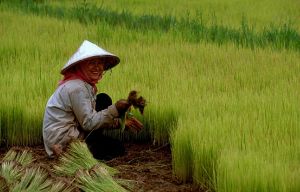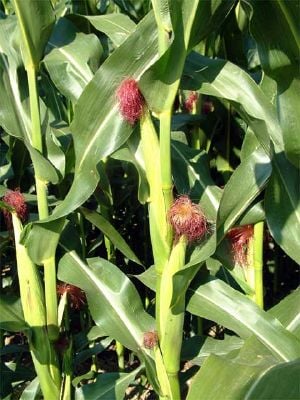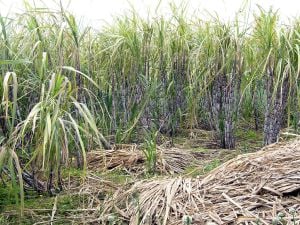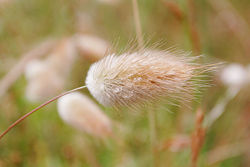Grass
| True grasses | ||||||||||
|---|---|---|---|---|---|---|---|---|---|---|
| 240px Flowering head of Meadow Foxtail (Alopecurus pratensis), with stamens exserted at anthesis | ||||||||||
| Scientific classification | ||||||||||
| ||||||||||
| Subfamilies | ||||||||||
|
There are 7 subfamilies: |
The grass family, Poaceae, is one of the largest plant families, and to humans perhaps the most important. There are about 600 genera and perhaps 10,000 species of grasses. It is estimated grasslands comprise 20% of the vegetation cover of the earth.
What is Grass?
Grasses, like orchids and palms, are monocotyledonous, having only one cotyledon, or embryo leaf, rather than the two found in most flowering plants. Most grasses grow low to the ground, although a few, such as corn, sugar cane, and bamboo, are very tall.
Grasses generally have the following characteristics:
- Typically hollow stems (called culms), plugged at intervals (the nodes).
- Leaves, arising at nodes.
- Leaves differentiated into a lower sheath hugging the stem for a distance and a blade; a ligule (a membranous appendage or ring of hairs) lies at the junction between sheath and blade.
- Small, wind-pollinated flowers (called florets) sheathed inside two glumes (bracts), lacking petals, and grouped into spikelets, these arranged in a panicle, raceme, spike, or head.
- Fruit that is a caryopsis, the seed and fruit merged together to form a hard dry grain.
Grass leaves grow from the base of the blade. This enables them to quickly regrow after being eaten by animals, or mowed by a lawn mower. Most grasses send out creeping stems, called stolons if they grow above the ground and rhizomes if they grow below the ground, from which grow new plants. Some grass species are annual, dying at the end of each growing season and leaving seed to grow a new generation the next season, while some are perennial, living for more than one or two years.
Grass in Nature
Most grasses grow in places that are too dry for forests. Grasslands are areas dominated by grass. Prairies are found in temperate climates with moderate rainfall. They have taller grasses than other grasslands. Prairies are found in the American Midwest, eastern Argentina, Hungary, and northeastern China. Steppes are found in dryer areas with cold winters. They are found in western North America and Russia and central Asia. Savannas are glasslands with widely spaced trees. They are found in tropical, subtropical, or temperate areas with seasonal rainfall. They cover large areas of Africa, India, North and South America, and Australia.
Many animals depend on the leaves and grains of grasses for food. Grasslands support a rich community of living things from large herbivores such as bison, kangaroos, and antelopes down to insects and worms. Many other types of plants besides grasses also grow in grasslands including trees, shrubs, and annual wildflowers.
Grass and Humans
Early humans ate the grains of grasses and hunted in grasslands. About 10,000 years ago people in the Middle East started to plant wheat, barley, and other grasses and harvest the grains. Over many generations the plants changed and become domesticated, different from their wild ancestors and dependent on humans for survival because their seeds became more tightly attached and had to be beaten off by threshing rather than scattering naturally. The same thing was happening with rice in the Far East and with corn in the New World. At the same time animals were also being domesticated and soon sheep, goats, and cattle were grazing on wild grasslands and providing food for humans.
Today most human food comes from grasses, directly as grain or indirectly as feed for meat and dairy producing animals. A great part of the world's grasslands have now been converted to human use. In the United States and Canada almost all of the old prairies are now corn and wheat fields. And cattle graze on much of the steppes and savannas. Besides food grasses also provide us with fuel and materials for construction and industry. They prevent erosion, decorate our gardens, and provide a surface for parks and sports fields.
Wheat

The wheat genus, Triticum, contains about 30 species. Two species of wild wheat, wild einkorn T. boeoticum wild emmer T. dicoccoides, still grow in the Middle East. Wheat is an annual, as are all other grasses grown for grain since they produce more seeds than perennials. It grows about 0.6 to 1.5 meters (2 to 5 feet) tall. Wheat is mostly grown in areas that are too cold for other crops. China, India, the United States, and Russia are the biggest wheat growing countries. Wheat grains are ground up making flour which is used to make bread, pasta, and other foods. Wheat straw is used to feed animals.
Rice
Almost all the rice grown is Asian rice, Oryza sativa. There is also an African rice, O. glaberrima, which was first domesticated in West Africa about 3500 years ago. Rice grows in a warm, humid climate and needs lots of water. Rice fields, or paddies, are flooded and drained several times during the growing season. About 90 percent of the world's rice crop is grown in Asia where it makes up the largest part of most people's diets. Rice plants stand about 1.2 to 1.8 meters (4 to 6 feet) tall, however never varieties have been breed that are only around 0.9 meters (3 feet) tall in order to prevent them from falling over as the grain matures, which had been a major cause of crop loss.
Corn
Corn, Zea mays, (or maize as it is called most places outside of the United States and Canada) was first domesticated about 10,000 years ago in Central America. It may be the result of hybridization of two or more wild species. Its cultivation spread thoughout North and South America so that by the year 1000 it was grown from from Chile and Argentina to southern Canada. It was introduced to the Old World by Columbus and within a hundred years it was a well established crop in Europe, Africa, and Asia. Corn can grow as tall as 9 meters (23 feet) but most variaties are about 2.5 meters (9 feet) tall. In the United States and Canada most corn is grown for food for cattle and other livestock. Much corn is consumed directly by people world-wide as whole corn, corn meal, and as corn starch, corn oil and corn syrup used as ingredients in other foods. It is also used to make alcohol and many industrial products. The United States is the largest corn grower producing about two fifths of the world's total crop, with China second.
Sugar Cane
Sugar Cane, Saccharum officinarum (hybridized with other Saccharum species), was first cultivated in Southeast Asia and neighboring islands about 8,000 years ago. From there it spread to India and then to China and to Europe and the New World. Unlike the grains it is a perennial; the stems can be harvested each year for up to ten years. In early times, and still today in areas where it is grown, people chewed on the soft inner pulp of the stems to get the sweet juice. The process of extracting the juice and crystallizing it into sugar started in India at least 2,500 years ago. This is the main use of sugar cane today. It is also being grown to produce alcohol as a substitute for gasoline, especially in Brazil. Brazil, India, China, Cuba, and Mexico are the leading sugar cane growers.
Bamboo
The various species of bamboo, members of the subfamily Bambusoideae, are not domesticated but are very useful to humankind. Bamboo grows in mostly the tropics and subtropics from the Southeastern United States through most of South America, in Africa, and in southern and eastern Asia and northern Australia. Some species can grow as tall as 40 meters (130 feet) making them the tallest grass by far. From prehistoric times people have used the woody stems of bamboo as a building material and to make many kinds of tools and other useful things. In recent years it has gained popularity as a flooring material and even as a substitute for steel reinforcement bars in concrete construction.
Lawns
Lawns developed from pastureland used to graze sheep and other animals. The animals kept the grass clipped to an even level which looked nice and provided a pleasant surface for strolling, resting, and sports. Towards the end of the Middle Ages lawns began to be maintained for their own sake rather than mainly to feed animals. In modern times, especially in the Twentieth Century, the number of lawns greatly expanded as more people owned homes and as cities and schools built parks and sports fields. Christina Milesa, in a NASA sponsored study, estimated the area of the lawns of the United States to be about 128,000 square kilometers (almost 32 million acres). This is three times the area used to grow irrigated corn. It is also estimated that 50 to 70 percent of U.S. residential water is used for landscaping, mostly to water lawns.
Lawns are planted with various species of perennial grasses (Kentucky bluegrass, Poa pratensis, is one of the most commonly used) and sometimes with clover and other plants. Besides their appearance they also have the benefit of cooling the air around homes, preventing erosion, filtering the air, and helping to absorb unwanted noise.
ReferencesISBN links support NWE through referral fees
- Brink, Francis E. and Rush, Paul J. (1962) Bamboo Reinforced Concrete Construction
- Brown, Lauren (1979) Grasses : An Identification Guide (Peterson Nature Library)
- Jenkins, Virginia Scott (1994) The Lawn: A History of an American Obsession
- Watson, L. and Dallwitz, M. J. (1992 onwards). The grass genera of the world: descriptions, illustrations, identification, and information retrieval; including synonyms, morphology, anatomy, physiology, phytochemistry, cytology, classification, pathogens, world and local distribution, and references.
- Kew Index of World Grass Species
- Definitions of Grass structures
- Poaceae in L. Watson and M.J. Dallwitz] (1992 onwards). The families of flowering plants: descriptions, illustrations, identification, information retrieval.
- Looking for Lawns - a general interest article about the NASA study
Credits
New World Encyclopedia writers and editors rewrote and completed the Wikipedia article in accordance with New World Encyclopedia standards. This article abides by terms of the Creative Commons CC-by-sa 3.0 License (CC-by-sa), which may be used and disseminated with proper attribution. Credit is due under the terms of this license that can reference both the New World Encyclopedia contributors and the selfless volunteer contributors of the Wikimedia Foundation. To cite this article click here for a list of acceptable citing formats.The history of earlier contributions by wikipedians is accessible to researchers here:
The history of this article since it was imported to New World Encyclopedia:
Note: Some restrictions may apply to use of individual images which are separately licensed.



